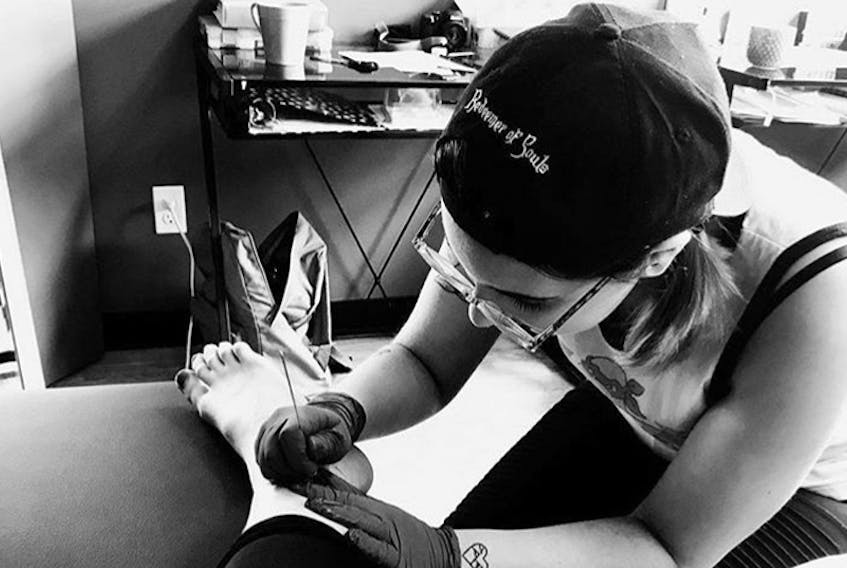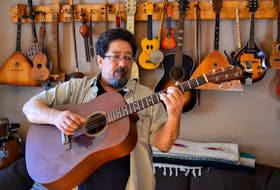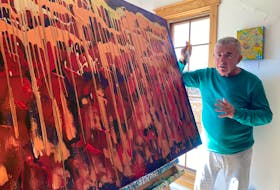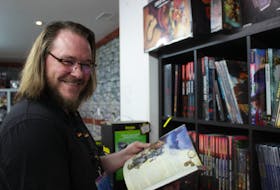From the time Ally Parsons was old enough to hold a crayon, you could rarely catch her without one. From there, she transitioned to pencil crayons, and eventually markers, her love of the arts only growing as the years went on. Today, you’ll still find Parsons with an artist’s tool in her hand, but most times it’s a tattoo needle.

Parsons is one of the only female tattoo artists in Nova Scotia offering professional, hand-poked tattoos. This traditional style of tattooing which consists of applying the tattoo one single dot at a time, has been around for centuries, but has been replaced in the mainstream tattoo industry, for the most part, by tattoo machines. Some artists around the world still use the original method to create their work. Traditional Japanese tattoos for example, called irezumi, are still done by the hand-poking method known as tebori.
As Parsons was growing up, tattoo-based shows like “Miami Ink” and “LA Ink” were taking over mainstream media, leaving their impression on the young girl.
“Suddenly, though still stigmatized, tattoos were something everyone was becoming interested in, not just bikers and sailors,” says Parsons. “It became a huge interest for me, watching other femme icons burst onto the scene and seeing how creative you could be with it. At 11 I believed I had found my dream job.”
In high school, Parsons thought long and hard about whether pursuing a career in the arts would pan out for her, or if she should consider a safer route in the sciences. Always having had a passion for learning in general, Parsons found herself torn, but settled on becoming an animator. After initially being accepted into NSCAD University, Parsons realized she needed more time to think about what she truly wanted, and found herself reconsidering a career in the tattoo industry.
She found an artist who was willing to show her the ropes, and began an apprenticeship in a local shop in Sydney, Nova Scotia. She was a fan of pointillism in her other forms of art, so she quickly fell in love with the hand-poked technique.
“I love the accomplished feeling you get after doing a piece and knowing it was done one dot at a time,” she says. “It also has the benefit of being less painful, quicker to heal, and useful for tattooing areas like the ears which can be irritating to work with when using a machine.”

Though hand-poking was the original method of tattooing, it became fairly obsolete following the creation of tattoo machines. Parsons explains that one of the reasons machines are more popular is because of how much can be accomplished in a short time frame, compared to a hand-poked tattoo which requires added precision and time. Artists across the world, including Indonesia and New Zealand, have kept up the traditional practices, but only recently has hand-poking made a comeback in modern tattoo parlours in North America.
Despite its growing frequency, the hand-poked method of tattooing is still looked down upon by some tattoo enthusiasts, who consider it less than, when compared to machine-work.
“It’s super disheartening to be asked when you’ll ‘move up’ or ‘upgrade’ to a machine,” Parsons explains. “It feels like they’re discrediting the hard work that goes into what I already do now.” Parsons knows there is a lot of misinformation surrounding hand-poked tattoos, much of which stems from the at-home practice of stick-and-poke tattoos, done by a sewing needle dipped in ink.
“I think some people see hand-poking as inferior and consider machine tattooing to be the true goal,” she says. “But in reality, some of the greatest modern tattooers I know use the hand-poked method and accomplish beautiful pieces that can happily stand alongside machine pieces.” Parsons intends to learn machine tattooing, but says hand-poking has a magic of its own and offers a unique set of perks and advantages that should be appreciated.

Parsons currently works out of The Rising Tide tattoo shop located in Sydney, Nova Scotia, and is the only female artist on staff. Although she says she is fortunate to work alongside some fantastic and kind men at the shop, the effects of working in a male-dominated industry still impact her every day.
“People will approach me instantly as the receptionist, or refer to the shop’s artists as the boys,” says Ally. “And there’s the added pressure of being judged by how you dress and present yourself as opposed to being judged solely by your work.”
But for Parsons, her clients make it all worthwhile. “I love my clients so very much,” she says. “It takes a while to get used to the surreal feeling of someone deciding to let you permanently alter their body. So I always feel very honoured that people not only feel safe with me, but trust in my artistic and professional skills.”
With numerous repeat clients who proudly show off their pieces on social media, it’s no secret that Parsons’ work is top notch.
“I love the accomplished feeling you get after doing a piece and knowing it was done one dot at a time.”
Tattoo artist Ally Parsons
While Parsons’ tattoo journey has already been an interesting and rewarding experience, she says she is still continuing to grow and enjoying every step of the way. Her goals for the coming year are to better herself and her tattoo education, learning as much as she can from those around her and continuing to grow as an artist. She is constantly in the process of learning, in order to expand the range of services she currently offers.
Her advice to others looking to break into the tattoo industry is simple: practice, practice, practice. “It’s cliché, but draw every day if you can, and do as much research as possible,” she says. “Hang out at local shops, get tattooed, observe the process and ask questions. If you stick around long enough, you may just come across someone looking to pass on their knowledge.”
At the end of the day, Parsons says she is so fortunate to be able to say that she loves her job wholeheartedly. “My clients and their reactions always make it worth it, and being able to work in an artistic field that I’ve dreamed of since age 11 is truly rewarding.”

Things to consider before getting a tattoo
- Cheaper isn’t better: Yes, bargain shopping is amazing, but not when it comes to tattoos. Choose a shop and artist based on their work, not their price tag. You get what you pay for when it comes to tattooing.
- Choose an artist you trust: Believe it or not, the bond between an artist and their client is a very important one. You want to choose an artist who makes you feel comfortable throughout the process, and whose artwork you’ll be proud to display on your skin.
- Your skin is unique: Everyone’s skin reacts differently to tattoos, so you can’t assume that you will have the same experience or pain level as a friend.
- Aftercare is key: The process isn’t over the minute you walk out of the shop. Taking care of your tattoo is extremely important, especially in the time directly following your appointment. Make sure to listen to your artist’s instructions; remember, they’re the professional!










